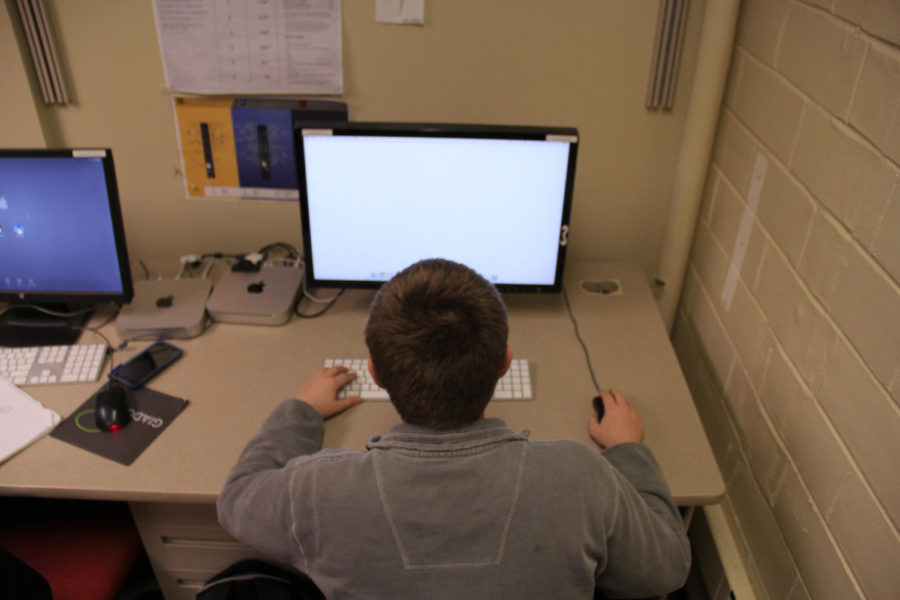Extended technology use leads to injury
By Charlie Coffey/Iowa State Daily
texting neck
February 15, 2015
Who would’ve thought that playing Trivia Crack or sending a text could cause so much damage?
Smartphones are widely known for the applications humans add to them. Users often don’t think of the consequences of hunching their head over to stare at the small screen.
Americans spend 162 minutes on their smartphones each day, according to a study by an advertising platform, Flurry. That adds up to about 59,000 minutes a year, or 41 days. About 32 percent of that time, according to the study, is spent playing games.
All that time playing Candy Crush can help students reach an all-time high level in helping solve the issues in Candy Kingdom, but can also cause students to obtain an unnatural posture.
Dr. Kenneth Hansraj, chief of spine surgery at New York Spine Surgery and Rehabilitation Medicine, found that the head sits at a 60 degree angle. By looking down at a cellphone, the head develops a pressure, which is the portion of the spine above the shoulders.
This pressure, according to the study, can be compared to having a 7- or 8-year-old sit on your back.
But gaming isn’t the only way the smartphone can affect your health. Today, text messaging is the most widely used mobile data service and about 2.19 trillion texts are sent annually by U.S customers, according to Portio Research.
When walking into a new classroom where every student in the classroom is unknown, the first thing that comes to mind is to search through social media instead of socializing with people. The origin of of this so-called “epidemic” is raised by the present generation and its use is forecasted to increase with more than 6 billion short message service messages sent per day, according to Forrester Research.
Katie Alexander, sophomore in advertising, explained how many texts she could send and the effects of texting at the end of the day.
“[I text] probably 100 times a day,” Alexander said. “My neck and my eyes hurt at the end of the day.”
Alexander thought about how this habit might affect her in the future.
“In my future, I might develop chronic neck and back pain, as well as a faster decrease in my vision,” she said.
Dr. John Moore, chiropractor for the Ames Back and Care Center, explained the usual cases he sees.
“People come in saying that by playing games they develop headaches, mostly for addiction to those games,” Moore said.
The neck and upper back are the most affected body parts from smartphones, Moore added.
“The neck and the upper back are the most affected by smartphones because your shoulders are trying to support, out in front of it,” Moore said. “Muscles are being stressed, which is not a good position. You work those muscles harder to support your head.”
Other parts of your body that are affected include the hands, especially thumbs and wrist. Texting repetitively can cause stress injury in these important parts. The effects on the thumbs can result in a decrease in grip strength, develop a form of tendonitis, carpal tunnel or even tenosynovitis.
Tendonitis and tenosynovitis are conditions in which the tissue connecting the muscle to bone becomes inflamed. Carpal tunnel is one of the worst cases that can happen, which leads to a pinched nerve in the wrist and causes a lot more pain than tenosynovitis and tendonitis. The worst cases of wrist damage lead to a call for immobilization with splints, medications or even surgery.
Joheshua Olvera, sophomore in pre-architecture, explained an interesting fact about texting and its effect on his health.
“My thumbs don’t hurt, but my pinky finger does because it supports my phone since I only text with one hand,” Olvera said.
Moore gave advice to those who constantly use their phones.
“People need to be careful with their position. Try to have an upright position,” Moore said. “Also, get something to support your arms or have someone hold your phone, this would be the most beneficial.”
Texting and gaming can also cause pain to children even faster due to the parents giving the child an iPad or cellphone at an earlier age. Children and young adults 8 to 18 years old spend more than seven hours a day on some type of entertainment medium.
A way to combat the effects on the eyes is to set the computer monitor’s brightness to match your surrounding workspace. Texting can damage the eyes and cause eyestrain or headaches.
Caroline Alva, sophomore in chemical engineering, said her eyes sometimes hurt due to the brightness in her technology.
“It strains my eyesight especially at night,” Alva said. “[Screens are] probably not good to look at for a long time because it’s such a small, bright screen.”
Dr. Magaly Gonzalez, an optometrist who practices in Puerto Rico, explained the consequences texting has on the eyes.
“By spending many hours working without having a rest can cause headaches, focus problems, migraines and also photophobia,” Gonzalez said.
Photophobia is painful oversensitivity to light, according to Medicine Net.
Gonzalez said she agreed that this generation is basically based on technology.
“This new generation involves a cyber network,” Gonzalez said. “Spending long hours on the computer causes a dry eye due to less blinking.”
Overall, the main piece of advice is to enjoy texting and technology but do so with healthy habits. Practice straight posture, try not to bend the neck as much, keep the brightness settings low and instead of sending a text message, make a phone call or make arrangements to see someone in person.







